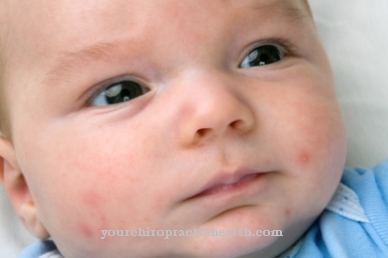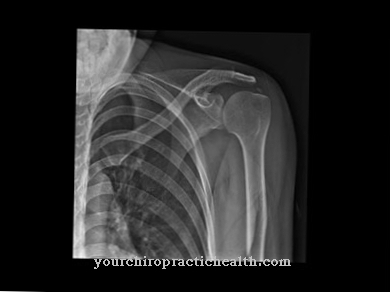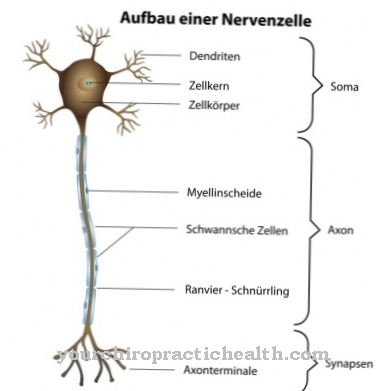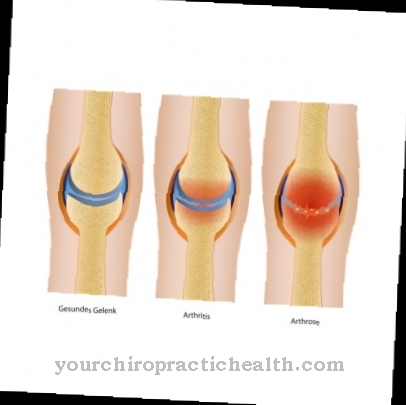The so-called Sickle foot or Pes adductus is found mainly in babies. Usually this malalignment of the foot recedes on its own or can be corrected therapeutically.
What is a sickle foot?

© photo4passion.at - stock.adobe.com
Of the Sickle foot is also known as Pes adductus and is a foot deformity that is considered the most common foot deformity among infants.
A sickle foot shows that the forefoot of an affected person has an inward rotation. This inner bulge usually affects both the metatarsus and the toes. Depending on the cause of a sickle foot, the big toe can also deviate inwards. This is called hallux varus. The heel position is often not impaired with a sickle foot.
In many cases, a sickle foot affects both feet. As a rule, a sickle foot is neither accompanied by pain nor by restrictions in the mobility of an affected person. In general, the foot position affects boys more often than girls.
causes
The cause of one Sickle foot is initially in the more active muscles of the so-called big toe adductor (a muscle that is responsible, among other things, for the attachment of the big toe to the foot) or the shin muscle.
A sickle foot can be congenital or acquired (developed after birth). The acquired sickle foot occurs more frequently, which is usually less pronounced than the congenital sickle foot. The acquired sickle foot often hides the fact that an affected infant is often prone, with the toes often resting on the mat.
An already congenital sickle foot can finally be hereditary or acquired. A sickle foot is hereditary if both parents of an affected infant have corresponding hereditary characteristics. An acquired, congenital sickle foot is probably often due to the relative tightness of the uterus.
Symptoms, ailments & signs
A sickle foot can usually be recognized from the outside. The malformation manifests itself in the fact that the tip of the foot and metatarsus are placed inwards and the toes are partially or completely shifted inwards. The heel is typically bent inwards or pointed forward. The deformations normally have no influence on the mobility of the affected foot.
Pain is also rare and only occurs as a result of any misalignment. In the congenital form, there is also an inward-facing gait. The sickle foot can occur on one or both sides. It usually occurs on both sides, although the severity of the symptoms can vary between the feet.
A congenital sickle foot is often accompanied by other malformations. Affected infants then have, for example, deformed big toes or a flattened metatarsus. This can lead to misalignments and, as a result, to joint wear, which is associated with pain and further restrictions on movement.
A sickle foot can therefore primarily be recognized by its external characteristics. The congenital form persists throughout life, and there is usually no deterioration in health. Early treatment can effectively relieve symptoms.
Diagnosis & course
Is diagnosed a Sickle foot mostly due to the visible, typical misalignment of the foot or feet. If hallux varus has developed, this usually suggests a congenital sickle foot.
A diagnosis of sickle foot is also supported by the fact that the foot is pointed straight ahead when you stroke the outer edge of the foot. If the degree of expression of a sickle foot is to be determined, an X-ray examination is suitable. In the vast majority of those affected, a sickle foot recedes on its own in the course of physical development.
In the remaining cases, the therapy prognosis is usually good. In a few untreated cases, a sickle foot can lead to pain, osteoarthritis and restricted mobility in the long term.
Complications
An untreated sickle foot can in rare cases cause complications. Due to the permanent misalignment of the foot, there is a risk that the metatarsus will stiffen. In addition, the foot, knee and hip joints wear out a lot, which permanently damages the articular cartilage. This is accompanied by damage to the bones - osteoarthritis occurs and with it permanent movement restrictions.
For many of those affected, the changed gait is also a cosmetic flaw that is perceived as unpleasant. In the long term, a misalignment can cause psychological problems such as inferiority complexes or exacerbate existing ailments. Surgical intervention can cause the typical complications: bleeding, infection and nerve damage. The joint capsules, which can be damaged during the operation, are particularly at risk.
This leads to sensitivity disorders and, in rare cases, permanent movement restrictions. Wound healing disorders and inflammation can occur after the operation. Occasionally, a misalignment occurs again, which must be treated again surgically. Prescribed pain relievers and anti-inflammatories can cause gastrointestinal complaints, headaches, muscle and limb aches and a number of other side effects and interactions. Allergic reactions to the agents and materials used cannot be ruled out.
When should you go to the doctor?
A sickle foot should always be treated by a doctor. In the worst case, this can lead to significant complications and restrictions in the life of the person concerned, which can have a very negative effect on the quality of life. For this reason, a sickle foot should be treated at the first sign. Self-healing cannot occur with this disease. A doctor should be consulted if the person concerned suffers from a significant misalignment of the foot. The heel is not pointing all the way forward, which can lead to severe pain in the feet.
As a rule, this pain occurs mainly while running, although it can also occur in the form of pain at rest. A doctor should be consulted immediately in the event of these complaints. Strong restrictions in movement also indicate a sickle foot and should also be checked by a doctor. Especially in children, parents need to pay attention to the symptoms of this disease and then see a doctor. Usually, sickle foot can be diagnosed and treated by an orthopedic surgeon.
Treatment & Therapy
In many cases a must Sickle foot not receive medical treatment. However, if a therapeutic measure is necessary, this often consists of manual correction of the sickle foot in the infant; if only the forefoot is affected by a sickle foot, repeated pressing of the affected foot into the normal position can fix the sickle foot.
Repeated stroking of the outer edge of the foot can also contribute to normal alignment of the sickle foot. Foam rings attached to the lower legs of an infant affected by sickle foot can also provide therapeutic support: in the prone position, the foam rings can prevent the infant's feet from lying with their outer edge on the mat.
Further therapeutic steps may be necessary if the metatarsus is affected by the sickle foot in addition to the forefoot. In this case, for example, plaster casts are applied to the thighs over a period of about one to three weeks, which are finally replaced by so-called storage trays that are to be worn at night. If affected children then walk and stand, special shoe inserts can be used to correct the sickle foot. In a few cases, surgical interventions may be necessary to correct a sickle foot.
prevention
Is a Sickle foot hereditary causes, its development can usually not be prevented. In order to prevent an acquired sickle foot, it can be helpful to avoid inward rotation of the feet in a prone infant. If the first signs of sickle foot appear, it can be useful to seek medical advice; if necessary, measures can be taken against the sickle foot at an early stage.
If a sickle foot is diagnosed in newborns, treatment is not always necessary, as spontaneous corrections are often made as they grow. If non-surgical therapies such as special splints, wraps or orthopedic shoes are unsuccessful, the positional misalignment can be corrected with a surgical procedure. In order to bring the foot back into its central position, plaster casts are also put on. In pre- and post-operative care, dimensionally stable positioning splints serve as a comfortable replacement for gisps. After an operation or after plaster therapy, intensive follow-up treatment with physiotherapeutic methods is necessary. Special stretching and strengthening exercises are carried out to stabilize the position of the feet. Physiotherapy is already useful for babies in order to avoid worsening the sideways rotation of the forefoot.
Aftercare
The physiotherapist treats the misalignment of the baby's foot with stroking massages that strengthen the foot muscles and mobilize the toes. During the sickle foot follow-up treatment, parents can independently carry out professionally guided exercises for stretching their feet at home. Regular medical checks are necessary, especially in the case of surgically treated malpositions, but also to ensure the success of conservative therapeutic measures.
Orthopedic shoe insoles serve to maintain the success of the treatment over the long term. As a complementary measure to successful physiotherapeutic aftercare, anti-varus shoes are also used. The health insurance companies bear the main costs for these stable shoes, provided that an orthopedic diagnosis has been made. A slightly pronounced sickle foot noticed later should also be examined by a doctor in any case.
You can do that yourself
Experience has shown that the sickle foot recedes by itself in the course of growth. Nevertheless, a medical diagnosis is urgently required - solely to document the progress of the individual measures.
Parents can support healing through massages. It is advisable to practice the corresponding hand movements first under therapeutic supervision. The muscles are gently brought into the ideal position. The elasticity of the foot on the inner edge is decisive for success. Exercise with a soccer ball is worthwhile for older children. In particular, kicking with the inside supports the healing process and is a lot of joy.
The sickle foot is a serious abnormality. The disease should therefore never be treated exclusively by laypeople. Otherwise, there is a risk of lifelong mobility problems with the resulting professional and private restrictions. Young adolescents can be supported by massages and exercise units. A combination of therapy and individual measures promises the best success.
In the event of complications, doctors try to correct the deformity with plaster casts and an operation. If this is not entirely successful, shoes with insoles often have to be used. Pain and pressure points after long journeys characterize everyday life.






.jpg)

















.jpg)



